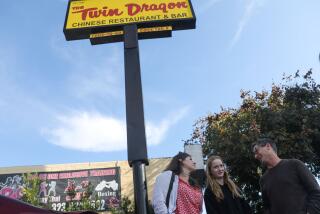Op-Ed: What Christmas was like in downtown L.A. in 1954
When I was a child, the greatest joy of Christmas was shopping in downtown Los Angeles. People from all over the city came to purchase gifts and enjoy the spectacular window displays.
This Christmas memory comes from 1954, when my family lived near the intersection of Pico Boulevard and Georgia Street. The Los Angeles Convention Center now sits on what was our old neighborhood of poor, working-class people. Our trolley ride to the Broadway district was only 10 minutes. My brother, who was 9, and I, a 4-year-old, were wild with anticipation.
Broadway was so crowded it was hard to make our way through the streets. People dressed up back then. Women sported hats and gloves. Men wore suits and fedoras.
When we got to the Broadway and Bullock’s display windows, we had to jostle up front for a viewing. There was so much to see: a sparkling winter fantasy world of snow and icicles; animals that twirled and sang; running electric trains full of presents. Christmas music piped outside over our heads. Delighted faces pressed against the glass.
Los Angeles, the city legendary for its endless, soulless sprawl, had a heart in the old downtown area.
We did most of our shopping at the Broadway. Bullock’s, much more expensive, was for browsing. I was mesmerized by the fashionable clothes, the heady smell of perfume, the shimmering crystal, silver and fine china. The upscale building of rich wood paneling and mirrors had an elevator run by a uniformed operator. He wore white gloves and with each press of a button would announce the floor and its various wares. We were squeezed against the smartly attired people who frequented this store. I recall stroking the back of a woman’s fur coat on a cramped ride.
My mother always gave me Christmas shopping money. I picked out something for my mother and brother, proudly handing the money to the clerk. My father’s gift was the easiest. Each Christmas throughout my childhood I gave him Old Spice aftershave and cologne.
There were huge movie palaces on Broadway. The smell of hot dogs and popcorn would waft out as we passed. Our hunger grew with the aromas as we made our way to Clifton’s Cafeteria.
Each room had a theme. My brother and I found the Santa Cruz forest especially enchanting. One huge wall was devoted to a life-sized painting of the woods. A tall waterfall produced a stream that wandered around the dining room and faux redwood trees. Birds and nature sounds played through speakers. Clifton’s was a restful escape from the crowds.
That Christmas Eve, we received our gifts through “Toys for Tots.” The superintendent of our apartment building, who volunteered, delivered an astonishing bounty. I felt guilty because I knew the presents were meant for unfortunate children. Having no awareness that we were poor, I thought this unexpected windfall came through a friendship with one of the program’s workers. It did not strike me as abnormal that four people lived in a furnished single or that I slept on a sofa next to my parent’s Murphy bed.
No matter what our circumstances, my parents made sure we always had a Christmas tree. During those very lean years, it sat on a table, trimmed with inexpensive dime store lights, balls and tinsel. We listened to Christmas music on the radio. My mother made egg nog.
Christmas morning, we walked to mass at Our Lady Chapel on Flower Street, a small Catholic place of worship for working people and tourists. After the service, we stopped on the way back for breakfast at the always open Pantry on Figueroa Street. With all the changes that have occurred in my childhood neighborhood, it is a comfort to know that Clifton’s Cafeteria has undergone a massive remodeling and the Original Pantry Cafe has survived the wrecking ball.
Los Angeles, the city legendary for its endless, soulless sprawl, had a heart in the old downtown area. To live there was to experience the wonderful closeness and diversity of its multi-ethnic people. Among the houses and brick apartment buildings, many small retail shops and services thrived. Whatever you needed was in walking distance or within a trolley ride. Everywhere you met your neighbors and stopped for a conversation.
In the 50s, the rumble of bulldozers signaled change. My brother and his friends played on the Harbor Freeway while it was being built. Developers eyed our neighborhood. If there were a few apartment buildings or houses that were run down, the entire quarter was labeled a blight and subjected to slum clearance. Bunker Hill was stripped of its lovely old Victorian mansions and became a district of commercial buildings and high-rises. Trolleys and tracks vanished, replaced by highways and cars. Friends and neighbors for decades bid one another goodbye as they were forced out.
Now downtown Los Angeles is going through yet another redevelopment. People want to live there again, in the mixed-use residences with stores and coffee shops at street level, or in the older commercial buildings converted into chic lofts. The tracks have returned. The working-class people, though, have not. I doubt there would be a place for a family like mine in today’s downtown.
Chrisandra Baker, now a Santa Fe, N.M., resident, is working on a memoir about her 1950s childhood in downtown Los Angeles and the Pico-Union area.
Follow the Opinion section on Twitter @latimesopinion or Facebook
ALSO
Tweeting through the apocalypse: Trump’s drive-by foreign policy
Some of the best displays of Christmas lights in the West
More to Read
A cure for the common opinion
Get thought-provoking perspectives with our weekly newsletter.
You may occasionally receive promotional content from the Los Angeles Times.






